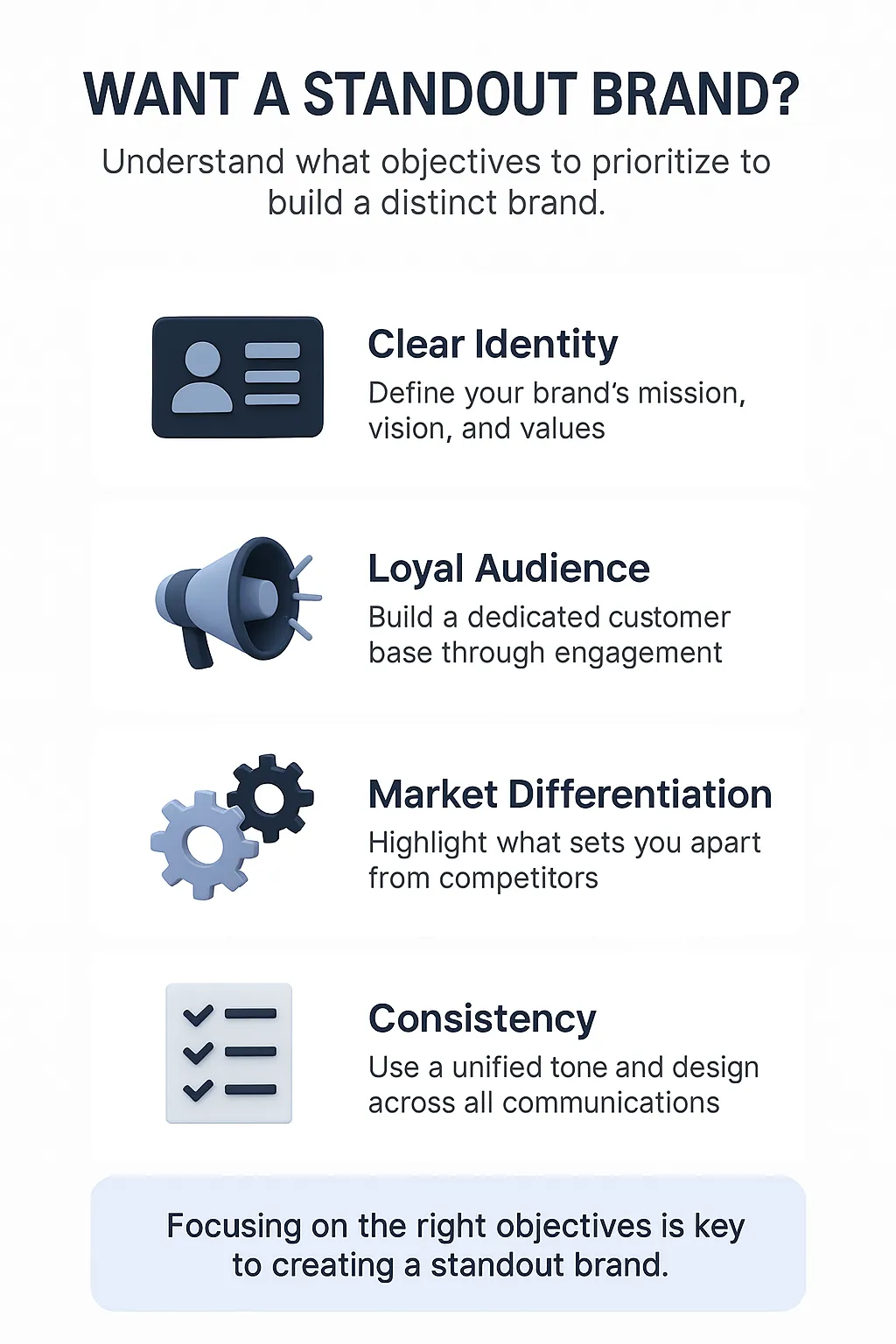Every remarkable brand you admire started with more than just a logo—it started with a clear plan. One of the most overlooked tools in creating a standout brand is a solid set of brand objectives. We've worked with everyone from fresh startups to market leaders, and across the board, the game-changer is the same: clearly defined brand objectives.
Too often, businesses mistake mission statements or taglines for direction. But brand objectives go deeper—they’re the strategic, measurable commitments that define how your brand looks, sounds, grows, and wins.
This article will guide you through what are brand objectives that can transform your brand from ordinary to unforgettable.
Top Takeaways
- Brand objectives give standout brands a sense of direction
- They are specific, measurable, and tied to real audience needs
- Clear objectives ensure consistent branding and trust
- Strategic objectives drive growth, loyalty, and brand strength
- Leading brands treat objectives as essential—not optional
What Brand Objectives Do You Need to Stand Out?
Brand objectives are like a compass for your business. They clarify your positioning, influence your messaging, and support long-term growth. Unlike your mission or vision, brand objectives turn intention into measurable action.
From what we’ve seen firsthand, effective brand objectives:
- Align with your business goals
- Resonate with your target audience
- Create consistency across every customer interaction
Example: Instead of saying “We want more customers,” a standout brand would say, “Increase first-time customer purchases by 30% through targeted onboarding emails over the next quarter.”
Expert Insight
“When we work with brands that want to stand out, the first thing we do is clarify their objectives. A clear, strategic goal is what separates market leaders from brands that blend in—and it’s exactly what a top branding agency helps define.”
Real-World Brand Wins from Smart Objectives
Case: Beauty Brand Finds Its Voice
One personal care brand lacked consistency and wasn’t retaining customers. We helped establish three focused brand objectives:
Build credibility through expert content
Improve retention with personalized loyalty messaging
Strengthen brand identity through community-led campaigns
The results after six months:
34% increase in email open rates
21% boost in returning customers
50+ social media posts featuring the brand organically
Example: Nike’s Strategic Brilliance
Nike has long been known for its iconic presence—but that’s no accident. Their standout brand power stems from brand objectives like:
Prioritize diversity and inclusion in storytelling
Innovate through sustainable product goals
Build direct customer relationships through DTC strategies
These objectives shape everything from product launches to social media posts.
One personal care brand lacked consistency and wasn’t retaining customers. We helped establish three focused brand objectives:
Build credibility through expert content
Improve retention with personalized loyalty messaging
Strengthen brand identity through community-led campaigns
34% increase in email open rates
21% boost in returning customers
50+ social media posts featuring the brand organically
Nike has long been known for its iconic presence—but that’s no accident. Their standout brand power stems from brand objectives like:
Prioritize diversity and inclusion in storytelling
Innovate through sustainable product goals
Build direct customer relationships through DTC strategies
Supporting Statistics: How Objectives Shape Standout Brands
Brands with consistent messaging grow 20% faster and generate 33% more revenue
(Source: Martech.org)
Georgia’s state digital team saw a boost in public trust by aligning design and voice
(Source: digital.georgia.gov)
The USDA found strong brand loyalty is tied to strategic messaging and repeat business
(Source: ers.usda.gov)
Brands with consistent messaging grow 20% faster and generate 33% more revenue
(Source: Martech.org)
Georgia’s state digital team saw a boost in public trust by aligning design and voice
(Source: digital.georgia.gov)
The USDA found strong brand loyalty is tied to strategic messaging and repeat business
(Source: ers.usda.gov)
Final Thought: A Standout Brand Is Built on Purpose
Brand objectives aren’t just tasks or KPIs—they are strategic commitments that build brand momentum. When we work with brands that want to go from forgettable to formidable, we don’t start with a rebrand—we start with goals.
Weak objective examples:
“Grow brand awareness”
“Be more engaging on social media”
Strong objectives look like:
“Boost social engagement by 40% through value-driven content within 6 months”
“Increase repeat purchases by 20% by launching a customer rewards system”
“Achieve 95% visual consistency across all brand assets by Q2”
Your standout brand starts here—with goals that matter, especially when guided by a multicultural brand marketing Ads firm.
“Grow brand awareness”
“Be more engaging on social media”
“Boost social engagement by 40% through value-driven content within 6 months”
“Increase repeat purchases by 20% by launching a customer rewards system”
“Achieve 95% visual consistency across all brand assets by Q2”
Next Steps to Building a Brand That Stands Out
Define What Success Means
Set specific and measurable goals tied to your brand’s purpose.
Align with Your Business Vision
Ensure every brand objective supports larger company milestones.
Audit Your Brand Touchpoints
Look for inconsistencies in messaging, visuals, and customer experience.
Write and Share Your Objectives
Make them clear, actionable, and accessible to your entire team.
Track and Refine
Use data and feedback to adapt your objectives quarterly.
Consider Expert Support
A strategic partner can help refine your goals and accelerate execution.
Pro Tip: A standout brand isn’t louder—it’s more focused.
Set specific and measurable goals tied to your brand’s purpose.
Ensure every brand objective supports larger company milestones.
Look for inconsistencies in messaging, visuals, and customer experience.
Make them clear, actionable, and accessible to your entire team.
Use data and feedback to adapt your objectives quarterly.
A strategic partner can help refine your goals and accelerate execution.



